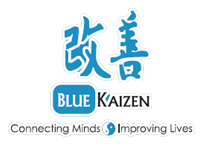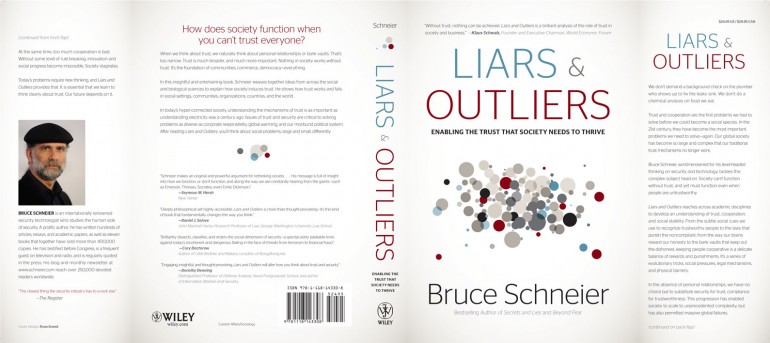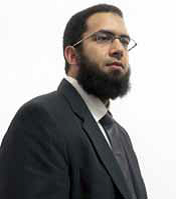Book Review: Liars and Outliers
Did you check the ID of the plumber before allowing him into house? Did the plumber validate the authenticity of your money? Did you test the food you bought from the grocery for poison? And, did you scan your neighborhood’s buildings roofs for signs of snipers targeting your head?
I don’t really know, but what I know is that Bruce Schneier didn’t! At least that’s what he claims Liars and Outliers: Enabling the Trust that Society Needs to Thrive. Liars and Outliers, the book by the security black-belt Bruce Schneier, proposes a genuine view on security. It is entirely dedicated for the very specific topic of trust, and how it affects the overall functioning of a thriving society.
According to Schneier, “the more trust is in the air, the healthier the society is, and the more it can thrive,” for which he proposes various models and interpretations for how people interact with each other, and with the group (which may be a family, a community, an enterprise or any other sort of collection), considering norms, competing interests, societal pressure, societal dilemmas and various other aspects that formulate trust.
Why trust? Simply, according to the author, because it performs three critical functions:
• It makes social life more predictable
• It creates a sense of community
• And it makes it easier for people to work together
The book is divided into four parts. Part I is about the science of trust. It explores various sciences that feed the existence of trust, not only in humans, but also in other species. Schneier talks about concepts from psychology, sociology, biology, neuroscience, philosophy, systems dynamics, history, cognitive science, behavioral economics, computer security and various others.
A notable chapter in this part is the last one about Societal Dilemmas. Which should be prioritized, the person’s, or the group’s interest? A popular example from the game theory is The Prisoner’s Dilemma, which is a generalization of all societal dilemmas. Alice and Bob were arrested for a crime, but without enough evidence for conviction.
Each of them is interrogated separately and offered a deal: “If you testify against your partner, you’re free. If you both testify against each other, both of you will get six years of jail. But if you cooperate and remain silent, you’ll only be charged for one year.” So, neither Alice nor Bob is in charge for his own decision. Each of their decisions will affect the other, and the probabilities are blurry. Should I sort for my own interest, or for the group’s interest? And what about the other, what decision shall he make and how will it affect my status? And this is where the model of trust plays a critical role in the decision making.
Part II is where the model formulates. As societies need trust to function, various forms of societal pressures play role to induce cooperation (as a product of trust) in societal dilemmas. These are:
• Moral pressures, which comes from inside our own heads
• Reputational pressures, which result from how others respond to our actions
• Institutional pressures, which are the codified norms and are enforced by the delegate authorities
• Security systems, which include everything that prevents defectors from violation such as door locks, antivirus software, audit systems, mitigation plans … etc
Part III lands down to earth and talks about handles real world application of the model. It starts by introducing the actual complexities that result from competing interests from the group’s perspectives. He talks about Organizations, Corporations and Institutions, each in its own chapter.
Part IV is the conclusion talking about the times where societal pressure fail. He talks about change of technology and how it affects societal pressure, and the very particular characteristic of today’s society, the information society, and how it affects the entire model.
Throughout the inquiry, the author maintains a generally scientific approach, but there is one point where he fails. Every now and then, he keeps building his interpretation on the highly controversial evolution theory, which is commonly denied and refused by many scientific and religious schools. He deals with the theory as a matter of fact, without presenting (or even referring to ) a valid proof for it, or explicitly stating his assumption of its validity. However, this does not obviously affect the overall model proposed by the book, even though it reduces the credibility of the interpretations.
Will you be interested in this book? If you are a security theorist, a strategic thinker, a sociologist, a prime minister, or even someone who wants to know how security works, you’ll definitely will! It takes our understanding to the bird’s-eye view on how security works in the real life in an exciting sequence, building the entire picture inside your mind piece by piece, until it comes to the now-way-back point where you find yourself shifted to a totally new paradigm about security!
It is definitely a page-turner that once you start reading a chapter of, you can hardly take your eyes off the page until you finish it. It presents a very high level, generic view on trust, as one of the security artifacts, and the necessary conditions for societies to thrive
About The Author
Mostafa El Masry, security researcher, activist and a trainer.


